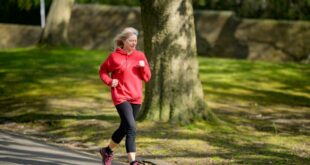Fitness is about adaptability – when we are fit, we tend to be more agile, flexible and energetic. When our bodies are functioning at an optimal level, it is easier to maintain a healthy weight, fight infection and manage stress. As seems to be the case with many things, exercising as we age means adjusting our approach and in some cases, expectations.
Our metabolism naturally slows with every birthday and the accumulation of a lifetime’s knocks and injuries can mean the exercise that once worked well for our body, needs revision.
The good news is regular exercise can compensate for some natural physical losses and help your body feel years younger.
Experts estimate by participating in a training program, you can raise your aerobic capacity and strength which can translate to being 10-20 years younger. Efforts to increase and maintain overall strength and fitness in older adults improves their ability to live independently with a higher quality of life.
A lot of the problems we used to think of as being related to ageing, we now know aren’t related to ageing at all. They are related to disuse of the body. Not only will exercise improve your physical capacity, it has also been shown to improve mental acuity.
So, what is the best way to exercise for your age-type, not just your body type? Start by creating an attainable model for success. Aim for the most functional body you can, to attain a ‘better lifestyle and better health’ dream.
By the time you’re 50 or older, your body needs a little extra attention when you exercise, so pay attention to these guidelines:
Ask questions
Before you begin any health or fitness programme, discuss any pre-existing conditions with a medical professional. Anything that affects your condition should be addressed. Enlist the help of a certified trainer and ask them to base your programme on your physical age and take any limitations into account. The “no pain no gain” mentality is outdated and unsafe.
Let them know about all medications you’re taking. Some can cause fatigue, muscles aches, or other issues confused with workout issues.
Be clear about your fitness goals
Do you want to lose weight, get more energy, relieve pain, and strengthen joints? Seek expert guidance – start small and celebrate your success, rather than going too hard and ending up disheartened.
Don’t compete with anyone but yourself, or the memory of your former self. Set new, age-adjusted goals and compete with yourself only in the here and now.
Listen to your body, and be kind to it
It’s ok to push yourself a bit if you are feeling good, but if you are tired, convalescent, or sore, take it easy. Fitness is best compared to a marathon, not a sprint. If your body is saying take it slower, then take it slower.
Choose activities you enjoy now and vary them
If you are aiming to be active four days a week, then have a variety of workouts to choose from – you could do one long walk, one quick bike ride, one swim and a round of golf – it leads to more success in the long run.
Don’t forget the resistance
Having a great aerobic capacity is fantastic, but every body needs muscle mass to support their joints, stimulate their metabolism and hold a good posture. Weight bearing exercise is important, for both men and women.
Resolve issues quickly
Whenever your body is in a state of change, there is bound to be the odd ache and pain. Just as you must listen to your body during exercise, listen and seek help for any injuries quickly. The faster they are addressed, the faster you will be back on track.









Join the Discussion
Type out your comment here:
You must be logged in to post a comment.